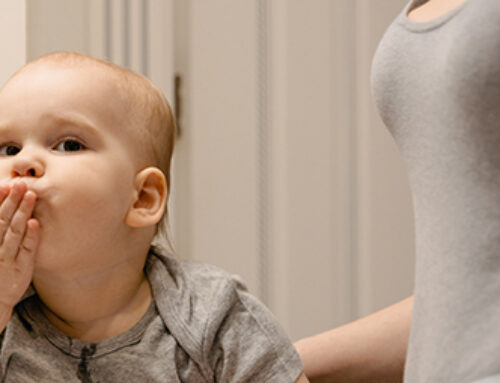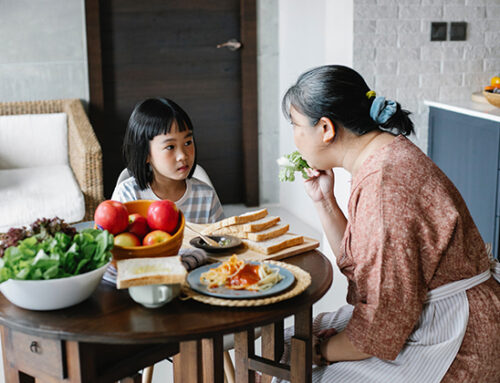As adults, we often take the skills of eating, drinking, and speaking for granted. In actuality, these are incredibly complex processes that demand a multitude of oral motor skills to work together to function effectively. Lip closure and rounding are essential skills for learning to eat and drink safely and for the development of appropriate speech and articulation.
What is lip closure and rounding?
Lip closure is the ability to bring your lips together to form a seal. This skill is necessary to create what we call “labial” sounds such as “m, b, and p.” Lip seal is also crucial during mealtime as it allows a child to close her lips around a food item, spoon, fork, or drinking cup and receive nutrition.
Lip rounding is the ability to protrude one’s lips and bring them together into a circular shape. We see lip rounding when we produce the sounds “w” or “oh.” Lip rounding is essential for straw drinking and greatly assists in retrieving food from utensils.
Some children, such as those with low tone, developmental delays, or motor speech disorders, may have difficulty acquiring the skill of lip closure and rounding independently. Consulting a Licensed Speech-Language Pathologist is the first step to discovering if your child is developing these essential skills appropriately. Below are simple and fun activities you can practice with your child to help support the development of lip closure and rounding.
What can I do to help my child?
1. Model the skill with silly faces and sounds
Children learn through modeling and imitation. Take time to bring your child’s awareness to your lips and face. Practice making silly faces and saying simple words with “m, p, and b” sounds (e.g., “mama,” “papa,” ”buh-bye”) in front of your child or as you both look into a mirror. Mealtime is a great time to practice as well! Follow each bite of a preferred food with, “Mmm, yummy!” and encourage your child to say it with you. Practice giving and blowing kisses.
2. Increase tactile awareness
Some children benefit from physical prompts or touches to increase their awareness of their own lips and mouth. As you model the /m/b/p/ sounds for them, use your fingers to gently bring their top and bottom lip together. Give similar cues when your child is retrieving food from a spoon or fork.
As speech language pathologists, we often use a gentle vibrating tool called a Z-Vibe to increase tactile input to a child’s lips and mouth. You can emulate this exercise with an electric toothbrush. Help your child close their lips around the head of an electric toothbrush for 2-3 seconds with frequent breaks. Give them simple verbal directions such as “Close lips!” or “Squeeze!” Encourage your child to make an /m/ sound as he or she practices closing her lips around the device. Be aware that this stimulation may be difficult to tolerate for children with sensory differences and should be used mindfully.

3. Tug of war exercise
Find a highly preferred food item such as a lollipop and play a gentle game of “tug of war.” Place the food item in your child’s mouth and tell them you are going to try to pull it out. Instruct them to use their strong lips (not their teeth) to not let you pull it out! Complete 5-10 gentle tugs and then give your child a chance to swallow.
4. Blowing activities
Blowing bubbles is a fun and simple way to target lip rounding. Blowing bubbles through straws is a more advanced way to simultaneously target lip closure and lip rounding. Blowing through straws can also be used to make abstract art projects, racing pom poms across a table, or creating a “bubble mountain” in soapy water.
It is important to note that when working on oral motor skills in relation to speech production, it is essential to incorporate speech into the exercise. For example, encouraging your child to produce the /m/ sound when closing his or her lips around a Z-Vibe is more effective than being silent during the exercise if you are targeting speech skills. However, non-speech activities, such as the above tug of war exercise and blowing activities, are effective in practicing oral motor skills in connection with feeding and saliva management.
Remember to have fun! Making these exercises playful and enjoyable will help support your child’s willingness and motivation. Don’t be afraid to be silly and fill your play sessions with laughter!

Blue Bird Day fosters socialization, sensory regulation, and pre-academic learning in children ages 2-7 years in therapeutic rotations that simulate preschool and kindergarten settings. Our compassionate therapists practice a relationship-based and family-centered approach, provide parent training, and collaborate on goals and individualized intensive treatment plans for your child.
We believe in a collaborative and multi-disciplinary team approach to therapy. A team of occupational therapists, speech-language pathologists, dietitians, developmental therapists, behavioral therapists, physical therapists, and therapeutic assistants are created for each child to ensure child and family are fully supported and the best possible results are achieved.
Options for individualized, group and virtual therapy sessions are available as well.
Want to learn more or you have a specific question? Feel free to connect with us here!



